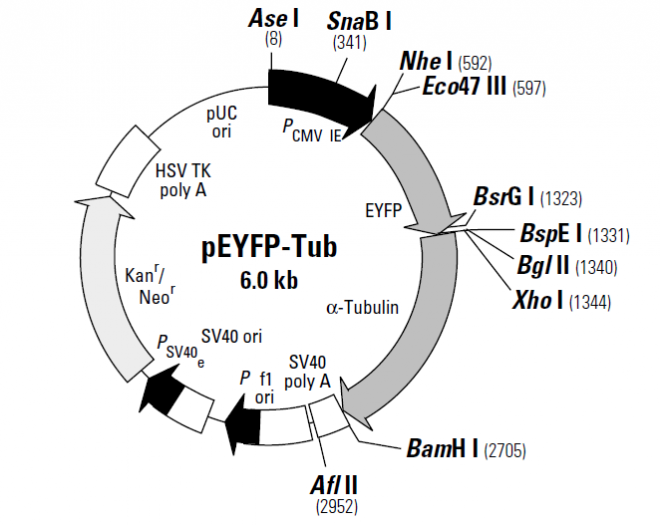pEYFP-Tub 载体
| 质粒类型: | 荧光蛋白报告载体 |
|---|---|
| 启动子: | CMV |
| 克隆方法: | 多克隆位点,限制性内切酶 |
| 载体大小: | 6045 bp (查看载体序列) |
| 载体抗性: | Kanamycin (卡那霉素) |
| 筛选标记: | Neomycin(新霉素) |
pEYFP-Tub encodes a fusion protein consisting of enhanced yellow fluorescent protein (EYFP) and human a-tubulin (1, 2). EYFP is an enhanced yellow-green variant of the Aequorea victoria green fluorescent protein (GFP; 3–5). The EYFP gene contains the four amino acid substitutions previously published as GFP-10C (6): Ser-65 to Gly; Val-68 to Leu; Ser-72 to Ala; and and Thr-203 to Tyr. It also contains the Phe-64 to Leu mutation of GFPmut1 (7). The fluorescence excitation maximum of EYFP is 513 nm; the emission spectrum has a peak at 527 nm (in the yellow-green region). When excited at 513 nm, the Em of EYFP is 36,500 cm–1M–1 and the fluorescence quantum yield is 0.63 (6), resulting in a bright fluorescent signal. The fluorescence observed is roughly equivalent to that from EGFP.
In addition to the chromophore mutations, pEYFP-Tub contains more than 190 silent base changes that correspond to human codon-usage preferences (8). SV40 polyadenylation signals downstream of the EYFP-Tub fusion direct proper processing of the 3' end of the mRNA. The vector backbone also contains an SV40 origin for replication in mammalian cells expressing the SV40 T-antigen. A neomycin resistance cassette (Neor) consisting of the SV40 early promoter, the neomycin/ kanamycin resistance gene of Tn5, and polyadenylation signals from the herpes simplex virus thymidine kinase (HSV-TK) gene allows stably transfected eukaryotic cells to be selected using G418 (9). A bacterial promoter upstream of this cassette drives expression of the gene encoding kanamycin resistance in E. coli. The pEYFP-Tub backbone also provides a pUC origin of replication for propagation in E. coli and an f1 origin for single-stranded DNA production.
载体应用
The pEYFP-Tub Vector is designed for expressing the EYFP-tubulin fusion protein in mammalian cells. pEYFP-Tub can be introduced into mammalian cells using any standard transfection method. If required, stable transformants can be selected using G418 (9). The protein incorporates directly into microtubules and thereby allows the observation of microtubules in living or fixed cells by fluorescence microscopy (10). pEYFP-Tub is not sold as a cloning vector; however, there are unique restriction sites at the 5' end of EFYP, at the EYFP-Tub fusion junction, and at the 3' end of the a-tubulin sequences. Note that the sites at the 3' end of the a-tubulin sequences are downstream of the stop codon.


